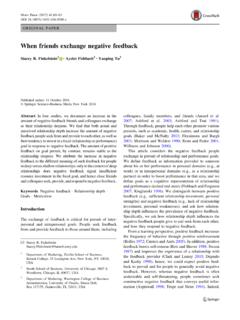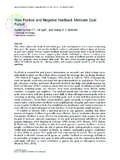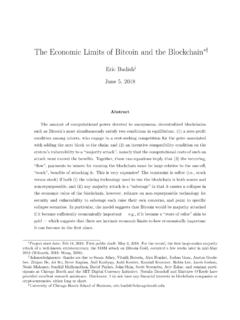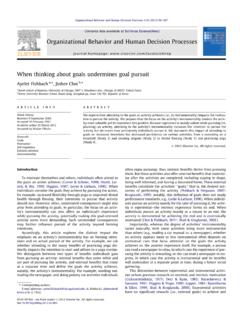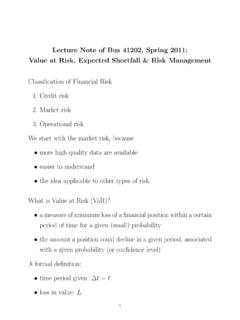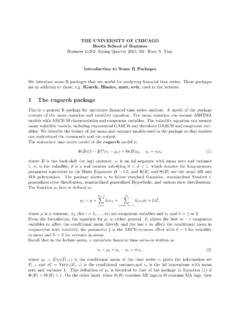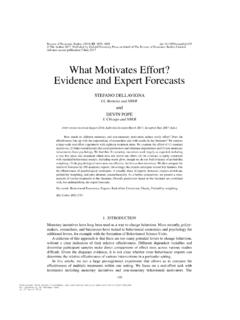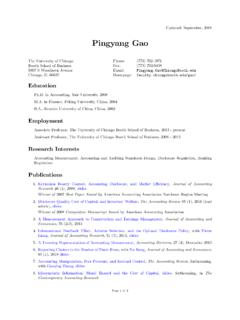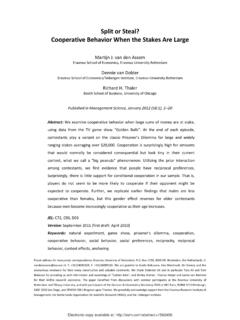Transcription of Housing Constraints and Spatial Misallocation
1 American Economic Journal: Macroeconomics 2019, 11(2): 1 39. Housing Constraints and Spatial Misallocation . By Chang-Tai Hsieh and Enrico Moretti*. We quantify the amount of Spatial Misallocation of labor across US. cities and its aggregate costs. Misallocation arises because high productivity cities like New York and the San Francisco Bay Area have adopted stringent restrictions to new Housing supply, effectively limiting the number of workers who have access to such high productivity. Using a Spatial equilibrium model and data from 220.
2 Metropolitan areas we find that these Constraints lowered aggregate US growth by 36 percent from 1964 to 2009. (JEL E23, J24, J31, R23, R31). S tarting with Hsieh and Klenow (2009), a large number of studies have docu- mented the existence and the costs of factor Misallocation across firms. In this paper, we focus on the Spatial Misallocation of labor across US cities. This analysis is motivated by the observation of a large and growing Spatial dispersion of nominal wages across US cities. After conditioning on worker characteristics, the standard deviation of nominal wages (in logs) across US cities in 2009 is twice as large compared to 1964, indicating that labor productivity is increasingly different across American cities.
3 If productivity of labor is vastly different across cities, output can in principle be increased by expanding employment in high productivity cities at the expense of low productivity cities. We argue that the growing dispersion of the nominal wage across cities reflects growing Spatial Misallocation which ultimately lowers aggregate growth in the United States. The increase in Spatial wage dispersion is driven at least in part by cities like New York, San Francisco, and San Jose, which experienced some of the strongest growth in labor productivity over the last five decades (Moretti 2012).
4 These cities also adopted land use restrictions that significantly constrained the amount of new hous- ing that can be built. As described by Glaeser (2014), since the 1960s coastal US cit- ies have gone through a property rights revolution that has significantly reduced the elasticity of Housing supply: In the 1960s, developers found it easy to do business in much of the country. In the past 25 years, construction has come to face enormous challenges from any local opposition. In some areas it feels as if every neighbor has veto rights over every project.
5 * Hsieh: University of Chicago, 5807 S. Woodlawn Avenue, Chicago, IL 60637, and NBER (email: ); Moretti: University of California, Berkeley, 619 Evans Hall, Berkeley, CA 94720, and NBER. (email: Richard Rogerson was coeditor for this article. An earlier version of this paper circulated under the title Why Do Cities Matter? Local Growth and Aggregate Growth. We are grateful to Klaus Desmet, Rebecca Diamond, Daniel Fetter, Cecile Gaubert, Ed Glaeser, Erik Hurst, Pat Kline, Steve Redding, Jose Vasquez, and several seminar participants for useful suggestions.)
6 We thank Jihoon Sung for research assistance.. Go to to visit the article page for additional materials and author disclosure statements or to comment in the online discussion forum. 1. 2 AMERICAN ECONOMIC JOURNAL: MACROECONOMICS APRIL 2019. Misallocation arises because the Constraints on Housing supply in the most pro- ductive US cities effectively limit the number of workers who have access to such high productivity. Instead of increasing local employment, productivity growth in Housing -constrained cities primarily pushes up Housing prices and nominal wages.
7 The resulting Misallocation of workers lowers aggregate output and welfare of workers in all US cities. This paper measures the aggregate productivity costs of local Housing con- straints through the prism of a Rosen-Roback model. In a Spatial equilibrium, aggregate output and welfare growth are not simply the sum of local shocks in each city. If workers can move across cities, a localized productivity shock in a city affects wages and employment not only in that city but also in other cities. We derive a formula that shows how local shocks aggregate to affect national output and welfare.
8 Aggregate output and welfare growth depend on a weighted average of productivity shocks in each city and the efficiency of the allocation of workers across cities, where the latter depends on the elasticity of Housing supply in high productivity cities. If a city with accommodating Housing supply experiences pro- ductivity growth, local employment rises and workers in other cities benefit from the reallocation of jobs. If instead the city has restrictive Housing supply, the real- location of jobs is limited and productivity growth in the city is dissipated by the higher price of Housing .
9 We use data from 220 metropolitan areas in the United States from 1964 to 2009. to perform two calculations. First, we quantify the effect of Spatial Misallocation . We find that most of the increased Spatial dispersion in the marginal product of labor is due to the growing Spatial dispersion in Housing prices. In turn, the growing Spatial dispersion of Housing prices is largely driven by strict zoning laws in cities such as New York and the San Francisco Bay Area with strong productivity growth. We find that the increased Spatial Misallocation of labor due to Housing supply Constraints in cities with high productivity growth rates lowered aggregate growth between 1964.
10 And 2009 by a significant amount. In particular, we calculate that increasing Housing supply in New York, San Jose, and San Francisco by relaxing land use restrictions to the level of the median US. city would increase the growth rate of aggregate output by percent. In this scenario, US GDP in 2009 would be percent higher, which translates into an additional $3,685 in average annual earnings. Second, we calculate the contribution of each US city to aggregate US growth and compare it to an accounting measure based solely on the growth of the city's GDP.
